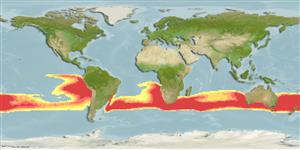Classification / Names
Common names from other countries
Main reference
Size / Weight / Age
Max length : 100.0 cm TL male/unsexed; (Ref. 27121)
Environment
Marine; bathypelagic; depth range 40 - 500 m (Ref. 27121)
Climate / Range
Deep-water, preferred ?; 2°N - 45°S, 180°W - 180°E
Distribution
Eastern Atlantic: Gulf of Guinea (Ref. 2683), St. Helena, Vema Seamount, Tristan da Cunha and South Africa. Western Indian Ocean: St. Paul and Amsterdam islands. Southwest Pacific: Australia (including Lord Howe Island), New Zealand (Ref. 5755) and Rapa Island. Southeast Pacific: Easter Island, Juan Fernandez Islands.
Countries | FAO areas | Ecosystems | Occurrences | Introductions
Short description
IUCN Red List Status (Ref. 115185)
Threat to humans
Harmless
Human uses
More information
Common namesSynonymsMetabolismPredatorsEcotoxicologyReproductionMaturitySpawningFecundityEggsEgg development
ReferencesAquacultureAquaculture profileStrainsGeneticsAllele frequenciesHeritabilityDiseasesProcessingMass conversion
Tools
Special reports
Download XML
Internet sources
Estimates of some properties based on models
Phylogenetic diversity index
PD50 = 0.5039 many relatives (e.g. carps) 0.5 - 2.0 few relatives (e.g. lungfishes)
Trophic Level
4.2 ±0.57 se; Based on food items.
Resilience
Low, minimum population doubling time 4.5 - 14 years (Preliminary K or Fecundity.)
Vulnerability
High vulnerability (61 of 100)
Price category
